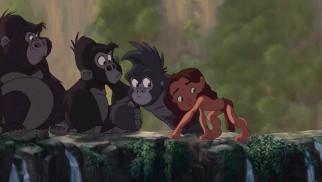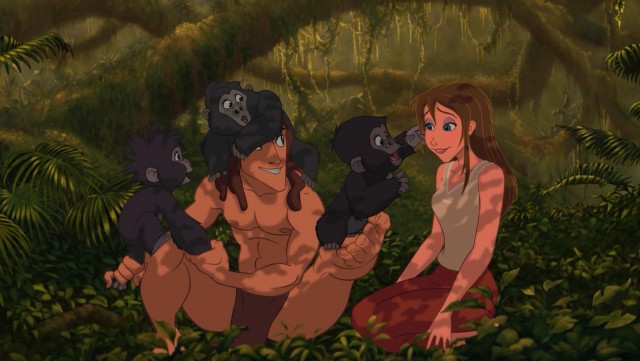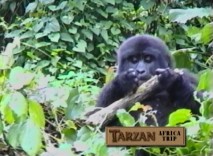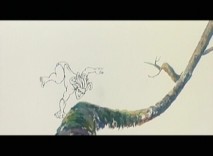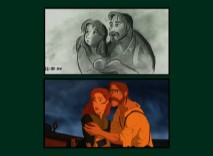Tarzan: Special Edition Blu-ray + DVD + Digital HD Digital Copy Review
 |
Tarzan
Theatrical Release: June 16, 1999 / Running Time: 88 Minutes / Rating: G Directors: Kevin Lima, Chris Buck / Writers: Edgar Rice Burroughs (story Tarzan of the Apes); Tab Murphy, Bob Tzudiker, Noni White (screenplay); David Reynolds, Jeffrey Stepakoff (additional screenplay material) Voice Cast: Tony Goldwyn (Tarzan), Minnie Driver (Jane Porter), Glenn Close (Kala), Alex D. Linz (Young Tarzan), Rosie O'Donnell (Terk), Brian Blessed (John Clayton), Nigel Hawthorne (Professor Archimedes Q. Porter), Lance Henriksen (Kerchak), Wayne Knight (Tantor), Taylor Dempsey (Young Tantor) Songs: "Two Worlds", "You'll Be in My Heart", "Son of Man", "Trashin' the Camp", "Strangers Like Me" |
Buy Tarzan from Amazon.com: Blu-ray + DVD + Digital HD • 1-Disc DVD • 2-Disc DVD • Instant Video
The first half of the 1990s kept lifting Disney up. Driven largely by their nearly annual output of celebrated animated features, the company saw rises in box office returns, acclaim, awards, and stock price. As the hit 1969 song "Spinning Wheel" says, "What goes up must come down." Disney experienced this form of professional gravity in the second half of the '90s. Disney had to do something to stop profits from shrinking even further. What they did was shake up their formula just slightly. The studio's June 1999 release, Tarzan, would be the first Disney animated film since 1990 that wasn't a musical. At the same time, such classification was practically semantical, because the film was full of original songs designed to advance the plot. They're even sung in the voice of the characters.
Not the speaking voice, but accomplished English singer-songwriter Phil Collins using first and second person pronouns like he's the protagonist or the protagonist's adoptive mother. The characters' mouths do not move with the lyrics of the song, which makes sense given that "apeman" Tarzan can barely string together a sentence in English. The effect is similar to the traditional Broadway-influenced musicals that had served Disney animation so well on hit films like The Little Mermaid, Beauty and the Beast, Aladdin, and The Lion King. But it's different enough to spare the studio charges of stagnancy and stubbornness.
Tarzan had a source newer than most of the '90s Disney films, which drew from old fairy tales, ancient Chinese legend, Victor Hugo, and, unofficially, William Shakespeare. Tarzan originated in a 1912 issue of the pulp publication All-Story Magazine. The character was so popular that Edgar Rice Burroughs wrote more than twenty novels for him, up until the author's 1950 death. Tarzan was one of cinema's first heroes, appearing on the screen as early as 1918. His adventures were also adapted for newspaper comic strips, radio, the Broadway stage, and television.
Disney Animation was far from the first to tell Tarzan's story, but they could do it in a way that had never been done before. And that's just what they did. Tarzan stands out in the Disney canon for being quite possibly the studio's most technically sophisticated 2D animated feature. Visually, the film represents a significant advance for the company. Full of "camera movement", it practically resembles a live-action production. It's also replete with computer-generated imagery, the likes of which had been used fairly sparingly in the past.
The CGI is implemented tastefully and never upstages the 2D character animation that is a clear product of Disney's winning cartoon tradition. The results are striking and satisfying; Tarzan offers a complex blend of old-fashioned artistry and new-fangled technological tools. Other films, like Disney's 2002 flop Treasure Planet, have tried to merge the two into something different and innovative, but to less accessible and pleasing effect. With Disney and other studios all but resigned to rely primarily on three-dimensional computer animation moving forward, we may never see anything quite like Tarzan in our lifetimes.
As the following year's costly Dinosaur would prove, all the dynamite visuals in the world cannot entirely compensate for lacking story and characterization. Fortunately, Tarzan is no slouch in these departments.
Comfortably fitting into a tradition of such nature stories as Bambi, The Jungle Book, and The Lion King, Tarzan opens with a baby whose parents are building their own paradise in the form of a treehouse within the African jungle. In adulthood, Tarzan (now Tony Goldwyn) discovers his human origins after encountering some of his kind. He meets Jane Porter (Minnie Driver), who is exploring the region with her father, a professor, and Clayton (Brian Blessed), their hunter guide. Tarzan picks up some English, learns about human civilization, and grows fond of Jane. But his fellow apes aren't as comfortable with their human guests, especially given the secret motives of the nefarious Clayton.
Assuming a role similar to Elton John on The Lion King but not settling for just singing over the end credits, Collins gives Tarzan a distinct, uniform, and appealing sound musically. The departure from the characters themselves opening up their hearts in song is subtle and minor, but it gives the film an emotional maturity that befits it. Collins' lyrics, nicely complementing Mark Mancina's score, define and develop characters, resulting in substance to match the rich, ample visual style.
Tarzan did just enough differently to strike a deeper chord with critics and moviegoers. Its box office numbers -- $171 million domestically and $277 M foreign -- were Disney Animation's biggest since Lion King and the department didn't do any better until 2010's Tangled. Tarzan spawned an animated television series (though one partially cast off to the UPN's "Disney's One Too" lineup rather than ABC's own "One Saturday Morning" block), three unaired episodes of which were adapted into the 2002 direct-to-video movie Tarzan & Jane. An official sequel/prequel/in-betweenquel, Tarzan II, focusing on Tarzan's childhood years, followed in 2005. A Broadway musical based on the film opened in 2006 and closed the next year.
Despite its initial success and assorted off-shoots, Tarzan no longer seems to stand noticeably above its fellow millennial efforts in terms of public admiration. Its 7.2 user rating on IMDb pales in comparison to Mulan and The Emperor's New Groove, not to mention being a far cry from the ratings of Pixar and Ghibli animated features from the around the same time (as well as The Iron Giant).
The film's home video history probably hasn't helped the public stay familiar with and fond of it: its two-disc Collector's Edition DVD was staggered in 2000, arriving two months after a plain DVD and with a much higher price tag. That edition was soon discontinued and replaced with a new 2005 release shortly after Tarzan II's debut that was advertised as a two-disc release but perplexingly ended up being one disc resembling its original standard DVD edition. Nine years later, Tarzan finally makes its Blu-ray debut in a 1-Blu-ray, 1-DVD Special Edition combo pack that thankfully devotes space to bonus features instead of the disappointing, childish Tarzan II. With no fewer than six other major Disney films hitting stores in Blu-ray + DVD + Digital HD Digital Copy combo pack the same day, let's hope the wonderful Tarzan doesn't get lost in the shuffle.
Though a concurrent new combo pack stripped Hercules of its original 1990s studio logos, Tarzan has its blue screens kept intact at the beginning and end.
It's worth noting that there is virtually no way that Tarzan would earn less than a PG rating from the MPAA if submitted today, but it kept Disney's G-rated streak alive for another year.
Watch a clip from Tarzan:
VIDEO and AUDIO
As one of Disney's most visually stunning animated films, Tarzan is something you hope looks good on Blu-ray. I'm happy to report that it looks about as good as current technology allows and that is extremely good. Presented in 1.78:1, achieved by slightly matting the 1.66:1 frame that made it to the original 2000 DVDs (and gaining a miniscule amount of frame width), the film looks flawless by any standard, showcasing great detail, vivid colors, bold lines, and a filmic look consistent with previous presentations. I honestly don't think it's possible for Tarzan to look any better on Blu-ray than this.
The Blu-ray upholds an odd tradition by presenting the film in 5.0 sound, rather than the usual 5.1. That 0.1 is supplied by subwoofers handling low-frequency audio; in simpler terms, it contributes bass. As in the past, though, Tarzan does not suffer from the lack of that channel (raising the question of its necessity). This is an exciting film aurally and the Blu-ray's lossless DTS-HD master audio excels at distributing the Phil Collins music and effective jungle sounds. There's definite improvement in both picture and sound over the once seemingly perfect 2000 DVD which I was heretofore relying upon.
BONUS FEATURES
Tarzan's Blu-ray gets much, much more than just the five extras listed on the back of the case. All of the extras are placed under the header Classic Bonus, which seems to be Disney's way of fessing up that there's nothing here you couldn't have seen before on one or more of the film's DVD releases. It also explains why all the extras remain in 1.33:1 standard definition. First up is a deleted scenes section running 9 minutes and 56 seconds with the "Play All" option. Producer Bonnie Arnold collectively and individually introduces the three cut sequences presented in story reel form. They are an alternate opening, Terk taking French lessons, and another Tarzan/Clayton showdown.
The bulk of material appears in Backstage Disney.
History and Development holds "From Burroughs to Disney" (2:40) about the story and what animation lends to it, an early presentation reel (1:58) teasing the film with concept art and Phil Collins chanting, and "Research Trip to Africa" (2:58) on the artists' observation of African animals and landscapes.
The Characters of Tarzan is home to six shorts gathering thoughts from the directors, supervising animators, voice actors and more on the leads' looks, movements, and personalities. They even share some pencil test animation. They are "Creating Tarzan" (4:04), "Animating Tarzan" (6:39), "Creating Jane and Porter" (2:58), "Creating Kala and Kerchak" (3:04), "Creating Terk and Tantor" (3:00), and "Creating Clayton" (3:22).
Under Animation Production, "The Deep Canvas Process" (2:43) describes the technique that gives the film its unique look, while "Deep Canvas Demonstration" (5:06) shows it in use at different stages and the scenes that used it most extensively.
A Production Progression Demonstration (1:07) presents a scene in the following formats: story reel, rough animation, clean-up animation, and final scene. It used to use angles to toggle through these different stages, but that seems to have been lost here. "Intercontinental Filmmaking" (2:05) reveals how animators collaborated from California to France by the magic of teleconferencing.
Story & Editorial holds two items. "Building the Story" (3:13) demonstrates the storyboarding process. A storyboard-to-film comparison (3:23) shows us how closely the film's opening sequence follows the sketches planned out for it.
A Publicity section kindly preserves three Tarzan trailers The kid-oriented "DisneyPedia: Living in the Jungle" (5:55) teaches viewers about the jungle animals depicted in the film: gorillas, leopards, baboons, and elephants.
The section wraps up with an audio commentary recorded by directors Chris Buck and Kevin Lima along with producer Bonnie Arnold. Beyond some silly introductions, the three take the track seriously and use it to dispense much information regarding how what is onscreen came to be. Topics covered include trying to differentiate from The Lion King, techniques (e.g. deep canvas) and ideas (like shadows denoting the gorillas' safety) employed, inspirations, homages, discarded ideas, and the discovery of a 1936 letter by Burroughs discussing the animation potential for Tarzan that suggested he'd be pleased by this adaptation. It is a worthwhile listen.
Under Music & More, we begin with "The Making of the Music" (2:51), a general piece on Phil Collins and Mark Mancina's songs and score.
"Tarzan Goes International" (2:24) addresses how the songs were translated into a number of different languages, Next up come four music videos. Collins' Oscar-winner "You'll Be in My Heart" (4:18) wants nothing to do with the movie and prefers you'd mistake it simply for a mainstream pop song. It features Collins singing in a transportation station, an underground night club, a movie theater, and other places where he's surrounded by the masses. On the other hand, "Strangers Like Me" (2:59), presented in a rocky "radio mix", fully embraces Tarzan with constant clips and Collins performing in jungle settings.
"Trashing the Camp" (2:06) is presented in a "studio session" which bounces between comments by Collins and his collaborators here, 'N Sync. Long-forgotten sister act Everlife covers "Strangers Like Me" (3:32) on stage to adoring youths for Disneymania 3, which was newly added for the 2005 Special Edition DVD.
The section closes with five original Phil Collins song demos (20:08), all but one of which made it into the film in some form. It's interesting to hear their evolution. They are introduced by executive music producer Chris Montan (1:51), who regrets being unable to use the one.
The DVD included here, oddly not available on its own, holds the three deleted scenes, and the following four making-of shorts: "Creating Tarzan", "Animating Tarzan", "The Making of the Music" and "Tarzan Goes International." The disc is somewhat close to capacity, but it's still perplexing why there was only room for these, which makes this platter a supplemental downgrade from the disappointing 2005 Special Edition DVD.
The discs open with trailers for Sleeping Beauty: Diamond Edition, Planes: Fire & Rescue, Legend of the Neverbeast, and an anti-smoking spot. The Sneak Peeks listing runs promos for Disney Movie Rewards, Disney Parks, and "Gravity Falls" before repeating the others.
WHAT'S MISSING?
Interactive content not easily transferred over to Blu-ray has been dropped. On its own, no loss is especially significant, but they do add up to a lot. From the original DVD and Disc 1 of the Collector's Edition, DVD-ROM content (a playable demo of the Tarzan action game and Internet Links) is dropped. Also gone but not forgotten are a Tarzan read-along, a trivia game, a Dinosaur sneak peek, a long illustrated original story treatment, text background on the history of Tarzan, and numerous galleries of concept art, color keys, character designs, layouts, backgrounds, and posters. Some of this material is likely to be missed, but short of reprinting the two 2000 Collector's Edition DVDs, that was pretty much inevitable.
MENUS, PACKAGING and DESIGN
The menu, which complicates navigation when only two listings appear on screen, sees Tarzan and his fellow wild jungle roamers trashing the camp to an instrumental version of the "Two Worlds" theme. The Blu-ray remembers where you left off on the film if you didn't finish it, but it doesn't make resuming playback any easier than that.
The side-snapped and slipcovered standard blue keepcase holds the two blandly labeled discs, your Disney Movie Rewards code (which doubles as the digital copy via the Disney Movies Anywhere program and iTunes) and a Disney Movie Club ad. Need it be said that you will find no chapter insert of any kind, let alone one resembling the Collector's Edition DVD's thick cardboard booklet with an essay, navigational overview, and artwork?
CLOSING THOUGHTS
The long-awaited Blu-ray debut of Tarzan warrants high praise. True, Disney hasn't added anything new to the mix, but it's something of a minor miracle that they have retained most of the bonus features from the movie's long out-of-print Collector's Edition DVD (one of the studio's first two-disc sets). Expectedly but unfortunately, galleries, text-based, interactive and DVD-ROM bonus features have not made the transition. Satisfyingly if not surprisingly, this technically innovative film has been treated to outstanding picture and sound. Most importantly, the film itself holds up very well, a minor departure from the studio's 1990s musical template that still easily provides the heart, humor, and excitement you expect of Disney feature animation.
Support this site when you buy Tarzan now from Amazon.com:
|
Related Reviews:
DVDizzy.com | Reviews | Disney Animated Classics | New and Upcoming DVD & Blu-ray Schedule | Upcoming Cover Art | Search This Site
DVDizzy.com Top Stories:
New: Hercules • Muppets Most Wanted • Bears • Turtle Power: The Definitive History of the Teenage Mutant Ninja Turtles
Directed by Chris Buck: Frozen • Surf's Up | Directed by Kevin Lima: Enchanted • A Goofy Movie • 102 Dalmatians
Music by Phil Collins: Brother Bear | Adapted from Edgar Rice Burroughs: John Carter | From the Screenwriters: Newsies • Tarzan
1990s Disney: The Lion King • The Hunchback of Notre Dame • Mulan • Pocahontas • Beauty and the Beast
Bambi • The Jungle Book • Tangled • The Emperor's New Groove • How to Train Your Dragon
Text copyright 2014 DVDizzy.com. Images copyright 1999 Walt Disney Pictures and 2014 Walt Disney Studios Home Entertainment.
Unauthorized reproduction prohibited.


